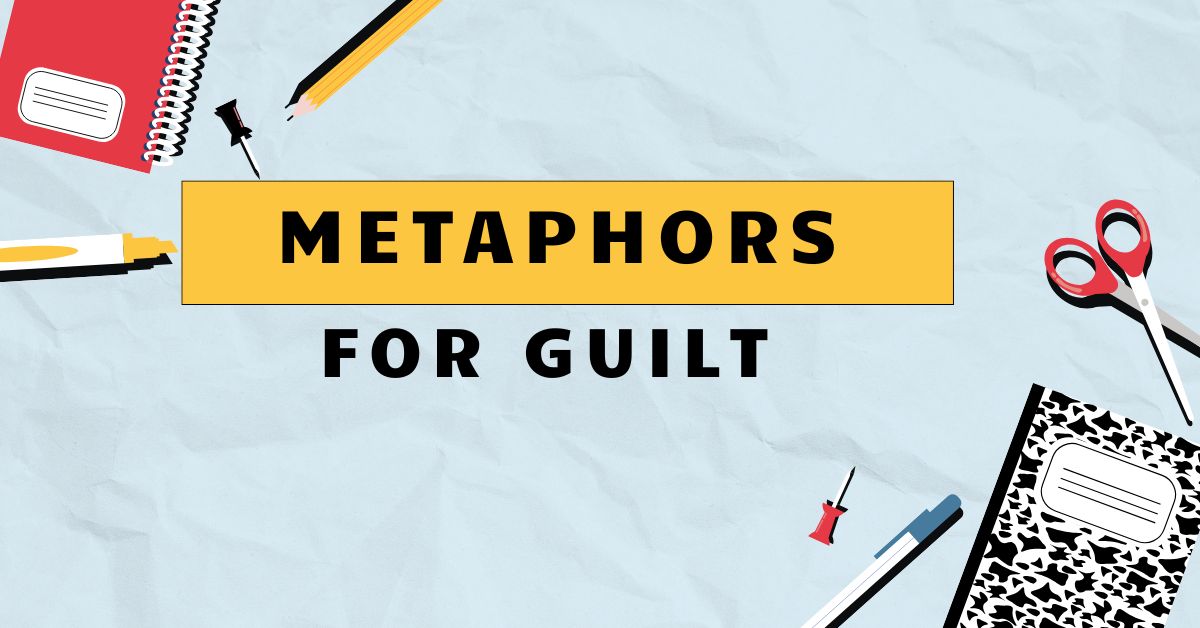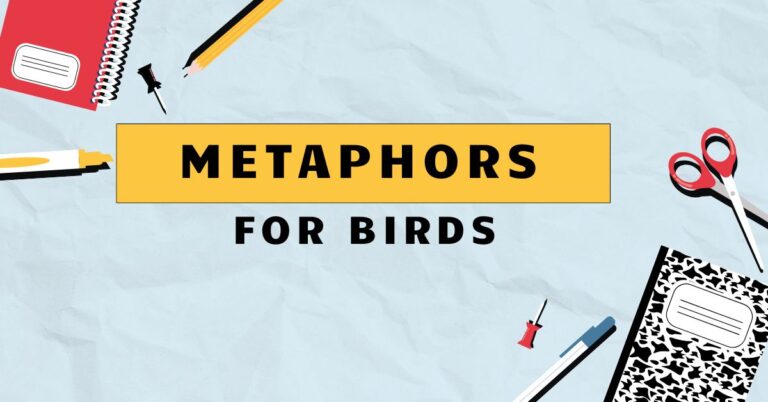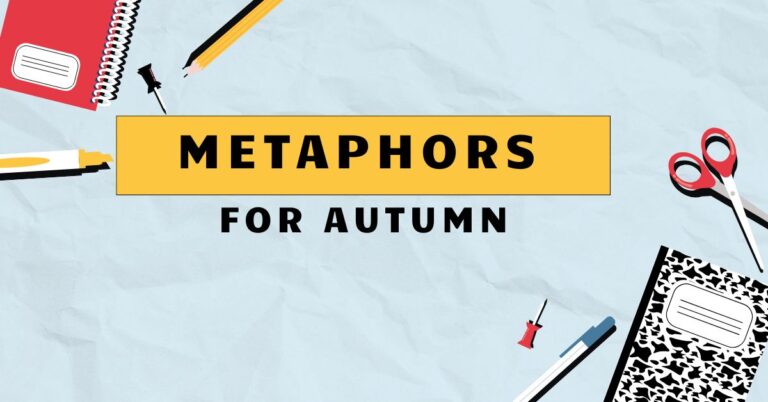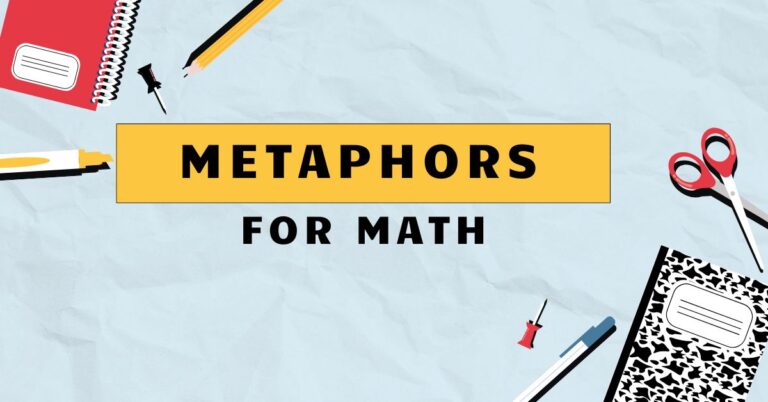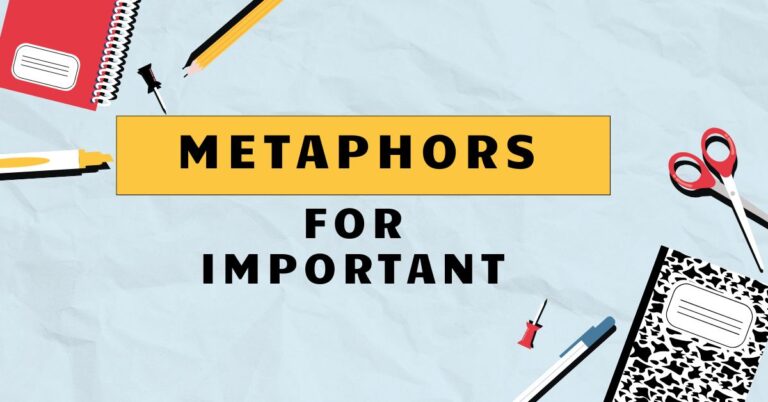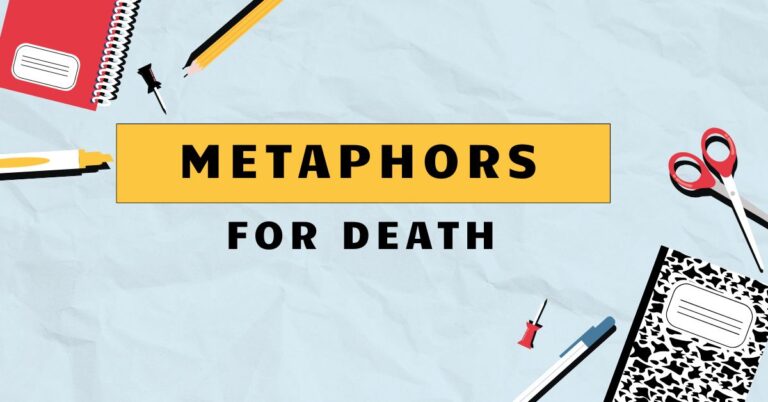39 Metaphors for Guilt: Understanding Figurative Language
Guilt, a complex and often painful emotion, can be difficult to express directly. Metaphors provide a powerful way to convey the weight, burden, and isolating nature of guilt, allowing us to understand and articulate its impact on our thoughts and actions.
Mastering the use of metaphors for guilt enhances both our writing and comprehension skills, enabling us to communicate and interpret nuanced emotional states effectively. This article is designed for English language learners, writers, and anyone interested in exploring the expressive power of language in describing the human condition.
Table of Contents
- Introduction
- Definition of Metaphors for Guilt
- Structural Breakdown of Guilt Metaphors
- Types and Categories of Metaphors for Guilt
- Examples of Metaphors for Guilt
- Usage Rules for Metaphors of Guilt
- Common Mistakes When Using Guilt Metaphors
- Practice Exercises
- Advanced Topics: Subtleties and Nuances
- Frequently Asked Questions
- Conclusion
Definition of Metaphors for Guilt
A metaphor is a figure of speech that directly compares two unlike things without using “like” or “as.” It asserts that one thingisanother, creating a vivid and often surprising connection in the reader’s mind. Metaphors for guilt use this technique to describe the abstract emotion of guilt in terms of more concrete and tangible concepts.
This allows us to better understand and express the often overwhelming feelings associated with guilt.
Specifically, metaphors for guilt borrow imagery and concepts from areas like physical burdens, stains, imprisonment, sickness, and darkness to illustrate the emotional and psychological impact of feeling guilty. By understanding these metaphorical representations, we can gain a deeper insight into the nature of guilt and its consequences.
The function of these metaphors is to provide a richer, more relatable understanding of guilt, going beyond simple definitions. They evoke emotions and paint a picture in the reader’s mind, making the experience of guilt more palpable and understandable.
The context in which these metaphors are used often dictates their specific impact; a metaphor within a literary work can carry significant emotional weight, whereas in everyday conversation, it might serve to simply emphasize the speaker’s feelings.
Structural Breakdown of Guilt Metaphors
The structure of a metaphor for guilt involves two key elements: thetenorand thevehicle. The tenor is the subject being described (in this case, guilt), and the vehicle is the object or concept used to describe it.
The connection between the two is what creates the metaphorical meaning.
For example, in the metaphor “Guilt is a heavy chain,” the tenor is “guilt,” and the vehicle is “a heavy chain.” The implicit comparison suggests that guilt, like a heavy chain, is burdensome, restrictive, and difficult to escape. The effectiveness of the metaphor depends on the shared characteristics between the tenor and the vehicle.
Metaphors for guilt often rely onimplied comparisonrather than explicit statements. Instead of saying “Guilt is like a weight,” a more powerful metaphor might be “The weight of guilt pressed down on him,” where the comparison is more subtle and evocative.
Understanding this structure helps in both interpreting and creating effective metaphors for guilt.
Types and Categories of Metaphors for Guilt
Metaphors for guilt can be categorized based on the type of imagery they employ. Here are some common categories:
Guilt as Weight or Burden
This is perhaps the most common type, portraying guilt as a heavy load that weighs a person down, both physically and emotionally. These metaphors emphasize the oppressive and debilitating nature of guilt.
Guilt as a Stain or Mark
These metaphors depict guilt as something that taints or blemishes a person’s character or reputation. They highlight the lasting and visible effects of guilt, suggesting that it is difficult to erase or hide.
Guilt as a Prison or Confinement
This category focuses on the restrictive and isolating aspects of guilt, portraying it as a prison that traps a person, limiting their freedom and ability to move forward.
Guilt as Illness or Disease
Here, guilt is likened to a sickness that infects the mind and body, causing pain, suffering, and a general sense of unwellness. These metaphors stress the damaging and corrosive effects of guilt on a person’s well-being.
Guilt as Shadow or Darkness
These metaphors emphasize the hidden, lurking nature of guilt, portraying it as something that follows a person, obscuring their happiness and casting a pall over their life. They highlight the way guilt can darken one’s perspective and create a sense of unease.
Examples of Metaphors for Guilt
Here are some specific examples of metaphors for guilt, organized by category:
Weight and Burden Examples
The following table provides examples of metaphors that use the concept of weight and burden to describe guilt. Each example illustrates how guilt can feel heavy and oppressive.
| Example | Explanation |
|---|---|
| The guilt was a heavy stone in his stomach. | Guilt is described as a physical weight, causing discomfort and unease. |
| She carried the weight of her actions for years. | Guilt is portrayed as a burden that she must bear over time. |
| The burden of his secret crushed him. | The secret, which is the source of his guilt, is a heavy weight that overwhelms him. |
| Guilt hung around his neck like a millstone. | The comparison to a millstone emphasizes the constant and inescapable nature of his guilt. |
| He was weighed down by the knowledge of his betrayal. | The knowledge of his betrayal is a heavy load that he carries. |
| The remorse was a leaden cloak that he could not shed. | The remorse is like a heavy coat that he cannot remove, symbolizing its persistent presence. |
| His conscience was a relentless taskmaster, piling on the guilt. | His conscience is personified as someone who adds to his burden of guilt. |
| The shame was a heavy anchor, holding him back from moving forward. | The shame prevents him from progressing in life, like an anchor holding a ship in place. |
| He felt the weight of responsibility pressing down on him. | The responsibility, which is tied to his guilt, feels like a heavy weight. |
| Her heart ached with the heaviness of her regret. | The regret causes her emotional pain, described as a physical heaviness. |
| The guilt was a cumbersome backpack he couldn’t take off. | He is forced to carry his guilt everywhere he goes. |
| He felt like he was carrying the world on his shoulders after the incident. | The speaker feels completely burdened and responsible for the incident. |
| The mistake was a heavy cross he had to bear. | He must suffer for his mistake. |
| His secret was a ton of bricks weighing him down. | His secret is very heavy and burdensome. |
| She felt crushed under the weight of her past. | She feels overwhelmed by her past actions. |
| The guilt was a boulder he had to push uphill. | His guilt is a difficult challenge that he must overcome. |
| He was drowning in a sea of regret. | He is completely overwhelmed by his regret. |
| Her conscience was a heavy chain, binding her to the past. | She is unable to move on from her past mistakes. |
| The guilt was a heavy fog, clouding his judgment. | His judgment is clouded by his feelings of guilt. |
| He felt like he was carrying a mountain of remorse. | He is carrying a large amount of remorse. |
| The weight of the lie was almost unbearable. | The lie he is carrying is oppressive and difficult to carry. |
| The guilt was a lead weight in his soul. | His guilt is a heavy weight on his soul. |
| He felt the burden of his secret crushing him. | His secret is a heavy weight that overwhelms him. |
| The mistake was a heavy stone tied to his ankle, dragging him down. | He is held back by the mistake he made. |
| He felt like he was shouldering the blame for everything that went wrong. | He feels responsible for everything that went wrong. |
Stain and Mark Examples
This table provides examples of metaphors that use the concept of stains and marks to describe guilt. These metaphors emphasize how guilt can taint or blemish a person’s character or reputation.
| Example | Explanation |
|---|---|
| The guilt stained his reputation. | His actions have tarnished his good name. |
| Her conscience was marked by the memory of that day. | The memory of that day has left a permanent mark on her conscience. |
| The lie left a permanent scar on their relationship. | The lie has caused lasting damage to their relationship. |
| His past mistakes cast a shadow over his present. | His past errors continue to negatively affect his current life. |
| Guilt etched itself into his soul. | The guilt has made a lasting impression on his soul. |
| The scandal left an indelible mark on her career. | The scandal has caused permanent damage to her professional life. |
| The memory of the accident was a brand on his mind. | The memory is a painful and lasting reminder of the event. |
| Shame painted a dark streak across her character. | The shame has negatively affected her character. |
| The secret left a tarnish on their friendship. | The secret has diminished the quality of their friendship. |
| His betrayal left a stain that could never be washed away. | His betrayal has caused irreparable damage. |
| The mistake left an ugly blot on his record. | His record is permanently damaged by the mistake. |
| Guilt left a bitter taste in his mouth. | He is left with a lingering sense of regret and remorse. |
| The scandal left a permanent blemish on his reputation. | His reputation is tarnished by the scandal. |
| His actions had left a permanent shadow over his family. | His family is permanently affected by his actions. |
| The memory of that day was like a dark stain on his soul. | The memory is a constant reminder of his guilt. |
| The guilt was a permanent scar on his heart. | He is permanently emotionally damaged by the guilt. |
| His secret sin had left a dark mark on his conscience. | His conscience is marked by his sin. |
| The scandal left a lasting impression on the community. | The scandal is still affecting the community. |
| Her mistake was a black mark on her otherwise perfect record. | Her mistake is a negative addition to her otherwise perfect record. |
| The guilt was a dark stain spreading through his life. | His guilt is affecting all areas of his life. |
| His betrayal left a permanent stain on their friendship. | Their friendship is permanently damaged by his betrayal. |
| The lie left a dark mark on his soul. | His soul is damaged by the lie. |
| His past mistakes haunted him like a shadow. | His past mistakes continue to affect him. |
| The mistake was a blemish on his perfect record. | His record is damaged by the mistake. |
| The guilt was an indelible mark on his conscience. | His conscience is permanently marked by the guilt. |
Prison and Confinement Examples
This table provides examples of metaphors that use the concept of prison and confinement to describe guilt. These metaphors highlight the restrictive and isolating aspects of guilt.
| Example | Explanation |
|---|---|
| Guilt held him captive in his own mind. | He is trapped by his own thoughts and feelings of guilt. |
| She was imprisoned by her past mistakes. | Her past actions prevent her from moving forward. |
| He lived in a self-made prison of remorse. | His remorse has created a mental prison for himself. |
| Guilt chained him to his past. | He is unable to escape his past actions. |
| He was trapped in a cage of his own making. | He has created the circumstances that confine him. |
| Her conscience was a jailer, constantly reminding her of her sins. | Her conscience acts as a prison guard, keeping her aware of her wrongdoings. |
| He felt confined by the walls of his own guilt. | His guilt creates a sense of restriction and isolation. |
| His secret was a locked room in his heart. | His secret is hidden and inaccessible. |
| She was shackled to her regret. | Her regret prevents her from moving freely. |
| He lived in a solitary confinement of guilt. | He is isolated by his feelings of guilt. |
| The guilt was a cage that trapped his spirit. | His spirit is crushed and confined by his guilt. |
| He felt like he was in a prison of his own making. | He feels responsible for his own confinement. |
| Guilt had built walls around his heart. | He is emotionally isolated because of his guilt. |
| His past mistakes were chains that bound him. | He is held back by his past mistakes. |
| He was trapped in a web of lies and deceit. | He is trapped by his own lies. |
| The memory of that day was a prison he couldn’t escape. | He is unable to escape the memory of that day. |
| His conscience was a jail, constantly reminding him of his sins. | His conscience acts as a prison guard, keeping him aware of his wrongdoings. |
| He felt confined by the walls of his own guilt. | His guilt creates a sense of restriction and isolation. |
| His secret was a locked room in his heart, never to be opened. | His secret is hidden and inaccessible. |
| She was shackled to her regret, unable to move forward. | Her regret prevents her from moving freely. |
| He lived in a solitary confinement of guilt, cut off from the world. | He is isolated by his feelings of guilt. |
| The guilt was a cage that trapped his spirit, preventing him from living freely. | His spirit is crushed and confined by his guilt. |
| His secret was a ball and chain, weighing him down. | His secret is a heavy weight that overwhelms him. |
| He was stuck in a loop of regret, unable to break free. | He constantly relives his regret. |
| The guilt was a fortress, isolating him from others. | His guilt isolates him from others. |
Illness and Disease Examples
The following table offers metaphors using illness and disease to depict guilt, emphasizing its damaging and corrosive effects on a person’s well-being.
| Example | Explanation |
|---|---|
| Guilt was a cancer eating away at his soul. | Guilt is destructively consuming his inner self. |
| Her conscience was infected with remorse. | She is deeply affected and tormented by remorse. |
| The secret festered like a wound in his heart. | The secret is causing increasing pain and suffering. |
| Guilt poisoned his mind. | Guilt is negatively affecting his thoughts and perceptions. |
| He was consumed by the disease of regret. | He is completely overwhelmed by feelings of regret. |
| His conscience was a sick and twisted thing. | His conscience is unhealthy and distorted due to guilt. |
| The guilt was a virus spreading through his life. | Guilt is negatively affecting all areas of his life. |
| He suffered from the malady of remorse. | He is experiencing the suffering caused by remorse. |
| His heart was heavy with the sickness of guilt. | His heart is burdened by the pain and suffering of guilt. |
| He was plagued by the disease of regret. | He is constantly tormented by feelings of regret. |
| Guilt was a sickness that he couldn’t shake off. | He is unable to get rid of the feelings of guilt. |
| His conscience was a festering wound, never fully healing. | His conscience is constantly causing him pain. |
| The guilt was a virus, infecting every aspect of his life. | His guilt is affecting all areas of his life. |
| His regret was a chronic condition, always present. | He is constantly feeling regret. |
| He was consumed by the disease of guilt. | He is completely overwhelmed by feelings of guilt. |
| The guilt was a tumor, growing larger every day. | His guilt is increasing over time. |
| His conscience was a festering sore, constantly reminding him of his sins. | His conscience is constantly causing him pain. |
| He was poisoned by guilt, unable to find peace. | He is unable to find peace because of his guilt. |
| The guilt was a parasite, feeding off his happiness. | His happiness is consumed by his guilt. |
| His regret was a chronic illness, always lingering in the background. | He is constantly feeling regret. |
| Guilt was a disease that had taken root in his soul. | His soul is damaged by his guilt. |
| His conscience was a festering wound, constantly causing him pain. | His conscience is constantly causing him pain. |
| He was poisoned by guilt, unable to find peace or happiness. | He is unable to find peace because of his guilt. |
| The guilt was a parasite, feeding off his happiness and well-being. | His happiness is consumed by his guilt. |
| His regret was a chronic illness, always lingering in the background, affecting his every decision. | He is constantly feeling regret. |
Shadow and Darkness Examples
This table provides examples of metaphors that use the concept of shadow and darkness to describe guilt, emphasizing its hidden and lurking nature.
| Example | Explanation |
|---|---|
| Guilt cast a shadow over his life. | Guilt negatively affects all aspects of his life. |
| She was haunted by the darkness of her past. | Her past mistakes continue to affect her. |
| His conscience was shrouded in a veil of secrecy. | His conscience is hidden and obscured. |
| Guilt darkened his spirit. | Guilt has negatively affected his inner self. |
| He lived in the shadow of his mistakes. | His past errors continue to define his present. |
| His soul was stained with the darkness of guilt. | His soul is negatively affected by his guilt. |
| The secret was a dark cloud hanging over their relationship. | The secret negatively impacts their relationship. |
| He was enveloped in a fog of remorse. | He is completely surrounded by feelings of remorse. |
| His heart was heavy with the shadows of regret. | His heart is burdened by feelings of regret. |
| He was lost in the darkness of his own guilt. | He is overwhelmed and consumed by his guilt. |
| Guilt was a dark specter looming over him. | Guilt is a constant and threatening presence. |
| His past was a dark shadow that followed him everywhere. | His past continues to affect him. |
| Guilt had cast a long shadow over his life. | Guilt negatively affects all aspects of his life. |
| He was haunted by the darkness of his past mistakes. | His past mistakes continue to affect him. |
| His conscience was shrouded in a veil of secrecy and regret. | His conscience is hidden and obscured. |
| Guilt darkened his spirit, leaving him unable to find joy. | Guilt has negatively affected his inner self. |
| He lived in the shadow of his mistakes, unable to escape the past. | His past errors continue to define his present. |
| His soul was stained with the darkness of guilt, forever marked by his actions. | His soul is negatively affected by his guilt. |
| The secret was a dark cloud hanging over their relationship, threatening to destroy it. | The secret negatively impacts their relationship. |
| He was enveloped in a fog of remorse, unable to see a way forward. | He is completely surrounded by feelings of remorse. |
| His heart was heavy with the shadows of regret, a constant reminder of what he had done. | His heart is burdened by feelings of regret. |
| He was lost in the darkness of his own guilt, unable to find a way out. | He is overwhelmed and consumed by his guilt. |
| Guilt was a dark specter looming over him, a constant reminder of his wrongdoing. | Guilt is a constant and threatening presence. |
| His past was a dark shadow that followed him everywhere, a constant reminder of his failures. | His past continues to affect him. |
| The guilt was a heavy curtain, obscuring all the light. | He is unable to see the positive aspects of life. |
Usage Rules for Metaphors of Guilt
When using metaphors for guilt, it’s important to ensure they are appropriate and effective. Here are some guidelines:
- Clarity: The metaphor should be understandable and relevant to the context. Avoid overly obscure or confusing comparisons.
- Consistency: Maintain consistency in the metaphorical imagery. Mixing metaphors can weaken their impact.
- Originality: Strive for fresh and original metaphors. Overused metaphors can become clichés and lose their power.
- Appropriateness: Consider the tone and audience. The metaphor should be appropriate for the situation and the intended readers or listeners.
- Emotional Impact: Ensure the metaphor effectively conveys the desired emotion and enhances the reader’s understanding of guilt.
Exceptions may occur in creative writing where unconventional metaphors can be used for stylistic effect. However, in most cases, clarity and appropriateness should be prioritized.
Common Mistakes When Using Guilt Metaphors
One common mistake is using clichés or overused metaphors, such as “Guilt is a heavy burden,” without adding any originality or depth. Another mistake is creating mixed metaphors, where the imagery becomes confusing and inconsistent.
For example, saying “Guilt is a heavy chain that festers like a wound” combines two different types of imagery (weight and illness) in a way that doesn’t quite work.
Here are some examples of common mistakes and how to correct them:
| Incorrect | Correct | Explanation |
|---|---|---|
| Guilt is a heavy burden. | The guilt was a leaden cloak that he could not shed. | The corrected version provides a more vivid and specific image. |
| His guilt was a dark cloud that weighed him down. | The shadow of guilt clung to him, obscuring his joy. | The corrected version uses more consistent imagery. |
| She was imprisoned by the weight of her guilt. | She was imprisoned by the bars of her own regret. | The corrected version focuses on the imprisonment aspect. |
Practice Exercises
Test your understanding of metaphors for guilt with these exercises:
Exercise 1: Identifying Metaphors
Identify the metaphor in each sentence and explain what aspect of guilt it emphasizes.
- The guilt was a persistent ache in his heart.
- She carried the secret like a ticking time bomb.
- His conscience was a relentless judge, condemning his every action.
- The shame was a dark stain on his character.
- He was trapped in a maze of regret.
- The guilt was a heavy shroud, suffocating his joy.
- His past mistakes were chains that bound him to the present.
- The remorse was a bitter pill to swallow.
- His guilt was a venomous serpent, poisoning his thoughts.
- She lived under the shadow of her past.
Answers:
- Ache: Emphasizes the constant pain and discomfort of guilt.
- Ticking time bomb: Emphasizes the impending explosion and anxiety associated with the secret.
- Relentless judge: Emphasizes the constant judgment and condemnation of guilt.
- Dark stain: Emphasizes the lasting and damaging effect of shame.
- Maze: Emphasizes the confusion and disorientation caused by regret.
- Heavy shroud: Emphasizes the suffocating and oppressive nature of guilt.
- Chains: Emphasizes the restrictive and limiting nature of past mistakes.
- Bitter pill: Emphasizes the unpleasantness and difficulty of accepting remorse.
- Venomous serpent: Emphasizes the poisonous and destructive nature of guilt.
- Shadow: Emphasizes the lingering and obscuring effect of the past.
Exercise 2: Creating Metaphors
Complete the following sentences by adding a metaphor for guilt.
- The guilt he felt was like __________.
- She carried her remorse as if it were __________.
- His secret was __________, slowly destroying him.
- The burden of his actions felt like __________.
- Her shame was __________, impossible to hide.
- His past mistakes were __________, haunting him endlessly.
- The guilt was __________, preventing him from moving on.
- She felt like __________, trapped by her own conscience.
- His remorse was __________, consuming his every thought.
- The weight of his secret was __________.
Possible Answers: (Many other answers are possible, depending on the imagery you choose.)
- The guilt he felt was like a relentless storm raging within him.
- She carried her remorse as if it were a fragile vase, always on the verge of shattering.
- His secret was a slow-burning fire, slowly destroying him.
- The burden of his actions felt like a mountain pressing down on his chest.
- Her shame was a scarlet letter, impossible to hide.
- His past mistakes were unseen chains, haunting him endlessly.
- The guilt was an invisible wall, preventing him from moving on.
- She felt like a bird in a gilded cage, trapped by her own conscience.
- His remorse was a ravenous beast, consuming his every thought.
- The weight of his secret was an anchor dragging him to the depths of despair.
Exercise 3: Sentence Completion
Fill in the blanks with a word or phrase that creates a metaphor for guilt.
- The ______ of his betrayal never left her.
- His guilt was a _______ in his soul.
- She was _______ by her past actions.
- The ______ of his secret weighed heavily on him.
- Her shame was a _______ that could not be erased.
- His past mistakes were _______ that held him back.
- The guilt was a _______ that suffocated his joy.
- She felt like she was in a _______ of her own making.
- His remorse was a _______ that consumed him.
- The weight of his secret was a _______ that dragged him down.
Possible Answers: (Many other answers are possible, depending on the imagery you choose.)
- The sting of his betrayal never left her.
- His guilt was a wound in his soul.
- She was haunted by her past actions.
- The burden of his secret weighed heavily on him.
- Her shame was a mark that could not be erased.
- His past mistakes were chains that held him back.
- The guilt was a shroud that suffocated his joy.
- She felt like she was in a prison of her own making.
- His remorse was a fire that consumed him.
- The weight of his secret was a stone that dragged him down.
Advanced Topics: Subtleties
Advanced Topics: Subtleties and Nuances
Beyond basic identification and creation, mastering metaphors for guilt involves understanding their subtleties and nuances. This includes recognizing how cultural context, personal experiences, and specific word choices can influence the interpretation and emotional impact of a metaphor.
- Cultural Context: Different cultures may have different associations with certain images or symbols. For example, the image of a “shadow” might evoke different emotions in a Western culture compared to an Eastern one.
- Personal Experiences: A person’s individual history and experiences can shape their understanding of a metaphor. Someone who has experienced physical confinement might relate more strongly to metaphors of imprisonment.
- Word Choice: The specific words used to construct a metaphor can significantly alter its impact. For example, “guilt as a scratch” is less intense than “guilt as a deep gash.”
Exploring these advanced topics allows for a deeper and more nuanced understanding of how metaphors function and how they can be used to convey complex emotions with precision and impact.
Frequently Asked Questions
Conclusion
Metaphors for guilt are powerful tools for expressing and understanding a complex emotion. By recognizing the structure, types, and usage rules of these metaphors, we can enhance our ability to communicate effectively and connect with others on a deeper level.
Whether you are a writer, a language learner, or simply someone interested in exploring the nuances of human emotion, mastering metaphors for guilt will undoubtedly enrich your understanding and appreciation of language.

